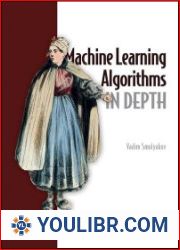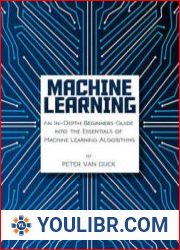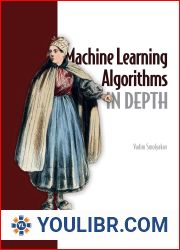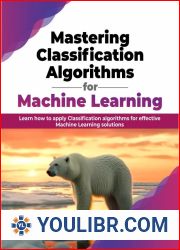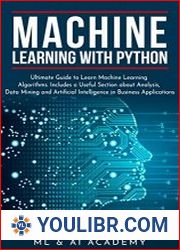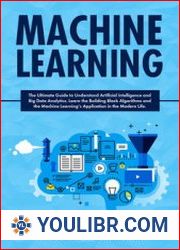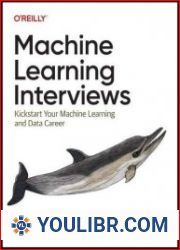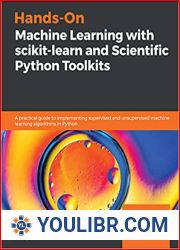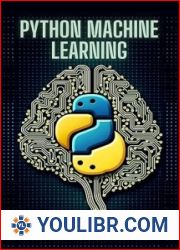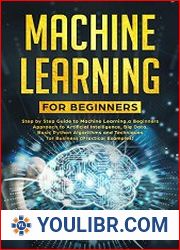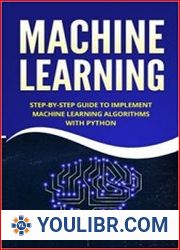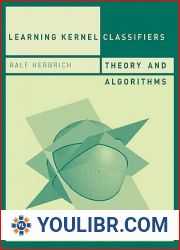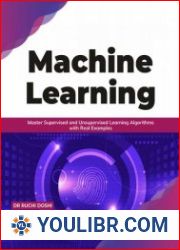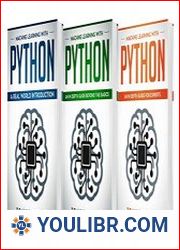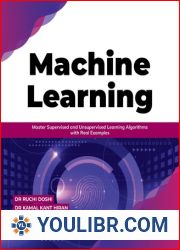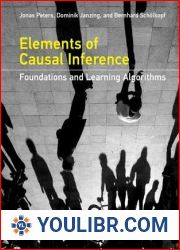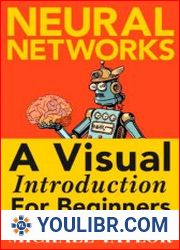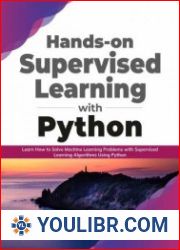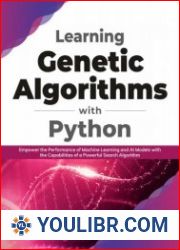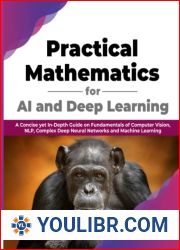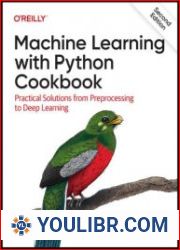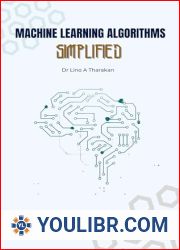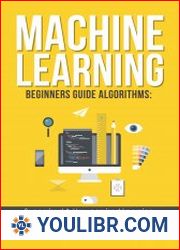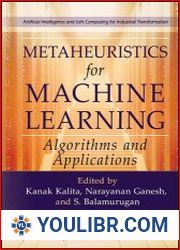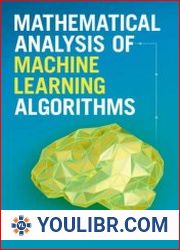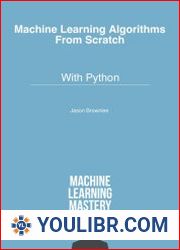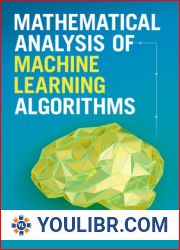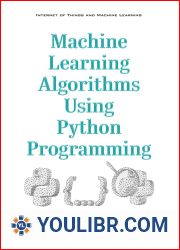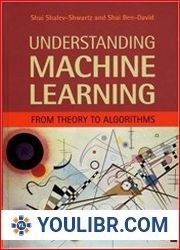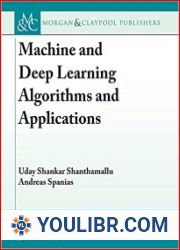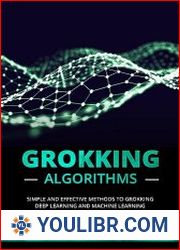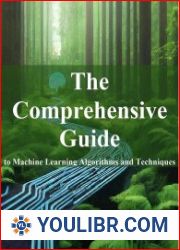
BOOKS - Machine Learning Algorithms in Depth (Final Release)

Machine Learning Algorithms in Depth (Final Release)
Author: Vadim Smolyakov
Year: 2024
Format: PDF
File size: 26.6 MB
Language: ENG
Year: 2024
Format: PDF
File size: 26.6 MB
Language: ENG
Learn how Machine Learning algorithms work from the ground up so you can effectively troubleshoot your models and improve their performance. Fully understanding how Machine Learning algorithms function is essential for any serious ML engineer. In Machine Learning Algorithms in Depth you'll explore practical implementations of dozens of ML algorithms. Machine Learning Algorithms in Depth dives into the design and underlying principles of some of the most exciting Machine Learning (ML) algorithms in the world today. With a particular emphasis on probabilistic algorithms, you'll learn the fundamentals of Bayesian inference and Deep Learning. You'll also explore the core data structures and algorithmic paradigms for Machine Learning. Each algorithm is fully explored with both math and practical implementations so you can see how they work and how they're put into action. Learn how Machine Learning algorithms work from the ground up so you can effectively troubleshoot your models and improve their performance. This book guides you from the core mathematical foundations of the most important ML algorithms to their Python implementations, with a particular focus on probability-based methods. Machine Learning Algorithms in Depth dissects and explains dozens of algorithms across a variety of applications, including finance, computer vision, and NLP. Each algorithm is mathematically derived, followed by its hands-on Python implementation along with insightful code annotations and informative graphics. You'll especially appreciate author Vadim Smolyakov's clear interpretations of Bayesian algorithms for Monte Carlo and Markov models. This book was written for anyone interested in exploring Machine Learning algorithms in depth. The prerequisites for reading this book include a basic level of programming skills in Python, and an intermediate level of understanding of linear algebra, applied probability, and multivariable calculus.
Book Machine arning Algorithms in Depth Final Release В современную стремительную технологическую эру важно понимать процесс эволюции технологий и его влияние на человечество. С быстрым развитием алгоритмов машинного обучения (ML) становится более важным разработать личную парадигму восприятия технологического процесса развития современных знаний. Эта книга, «Алгоритмы машинного обучения в глубоком окончательном выпуске», представляет собой исчерпывающее руководство по пониманию тонкостей алгоритмов ML, позволяющее читателям устранять неполадки в своих моделях и повышать их производительность. Как профессиональный писатель я буду вникать в необходимость и возможность выработки такой личной парадигмы, делая упор на выживание человечества и объединение людей в воюющем государстве. Книга начинается с изучения основных структур данных и алгоритмических парадигм для ML, закладывая основу для более глубокого понимания предмета. Он охватывает вероятностные алгоритмы, байесовский вывод и глубокое обучение, предоставляя тщательное объяснение каждой концепции. Автор, Вадим Смоляков, предлагает четкие интерпретации этих сложных алгоритмов, делая их доступными для читателей с разным уровнем экспертизы. Book Title: Machine Learning Algorithms in Depth Final Release Book Description: In today's fast-paced technological era, it is essential to understand the process of technology evolution and its impact on humanity. With the rapid advancement of machine learning (ML) algorithms, it becomes more crucial to develop a personal paradigm for perceiving the technological process of developing modern knowledge. This book, "Machine Learning Algorithms in Depth Final Release," provides a comprehensive guide to understanding the intricacies of ML algorithms, enabling readers to troubleshoot their models and improve their performance. As a professional writer, I will delve into the need and possibility of developing such a personal paradigm, focusing on the survival of humanity and the unification of people in a warring state. The book begins by exploring the core data structures and algorithmic paradigms for ML, laying the foundation for a deeper understanding of the subject matter. It covers probabilistic algorithms, Bayesian inference, and deep learning, providing a thorough explanation of each concept. The author, Vadim Smolyakov, offers clear interpretations of these complex algorithms, making them accessible to readers with varying levels of expertise. تنزيل ملف pdf pdf dosyasını indir скачать файл PDF PDF-Datei herunterladen Scarica il file pdf pobierz plik pdf download pdf file pdf 파일 다운로드 PDFファイルをダウンロード download pdf file descargar archivo pdf 下载 pdf 文件 להוריד קובץ PDF descarregar ficheiro pdf télécharger le fichier pdf
Learn how Machine Learning algorithms work from the ground up so you can effectively troubleshoot your models and improve their performance. Fully understanding how Machine Learning algorithms function is essential for any serious ML engineer. In Machine Learning Algorithms in Depth you'll explore practical implementations of dozens of ML algorithms. Machine Learning Algorithms in Depth dives into the design and underlying principles of some of the most exciting Machine Learning (ML) algorithms in the world today. With a particular emphasis on probabilistic algorithms, you'll learn the fundamentals of Bayesian inference and Deep Learning. You'll also explore the core data structures and algorithmic paradigms for Machine Learning. Each algorithm is fully explored with both math and practical implementations so you can see how they work and how they're put into action. Learn how Machine Learning algorithms work from the ground up so you can effectively troubleshoot your models and improve their performance. This book guides you from the core mathematical foundations of the most important ML algorithms to their Python implementations, with a particular focus on probability-based methods. Machine Learning Algorithms in Depth dissects and explains dozens of algorithms across a variety of applications, including finance, computer vision, and NLP. Each algorithm is mathematically derived, followed by its hands-on Python implementation along with insightful code annotations and informative graphics. You'll especially appreciate author Vadim Smolyakov's clear interpretations of Bayesian algorithms for Monte Carlo and Markov models. This book was written for anyone interested in exploring Machine Learning algorithms in depth. The prerequisites for reading this book include a basic level of programming skills in Python, and an intermediate level of understanding of linear algebra, applied probability, and multivariable calculus.
Saiba como os algoritmos de aprendizado de máquina funcionam do zero para que você possa resolver e melhorar o desempenho dos modelos. A compreensão completa de como funcionam os algoritmos de aprendizado de máquina é necessária para qualquer engenheiro sério da ML. Na seção «Algoritmos de aprendizado de máquina em profundidade», você vai estudar a implementação prática de dezenas de algoritmos ML. Os algoritmos de aprendizado de máquina (Machine Learning Algorithms in Depth) estão a mergulhar no design e nos princípios fundamentais de alguns dos algoritmos de aprendizagem de máquina (ML) mais excitantes do mundo atual. Com atenção especial aos algoritmos prováveis, você vai estudar os fundamentos da conclusão baiesa e o aprendizado profundo. Você também vai estudar as estruturas básicas de dados e paradigmas algoritmicos de aprendizado de máquina. Cada algoritmo é completamente estudado com implementações matemáticas e práticas para que você possa ver como eles funcionam e como eles são colocados em ação. Saiba como os algoritmos de aprendizado de máquina funcionam do zero para que você possa resolver e melhorar o desempenho dos modelos. Este livro guia você dos principais fundamentos matemáticos dos algoritmos mais importantes do ML para suas implementações em Python, com foco especial em métodos prováveis. O algoritmo de aprendizado de máquina de profundidade analisa e explica dezenas de algoritmos em várias aplicações, incluindo finanças, visão de computador e NLP. Cada algoritmo é matematicamente exibido, seguido por sua implementação prática em Python, juntamente com anotações perspicazes de código e gráficos informativos. Especialmente, você irá avaliar interpretações claras por Wadim Smolakov dos algoritmos baieses para os modelos Monte Carlo e Markov. Este livro foi escrito para todos os interessados em explorar os algoritmos de aprendizado de máquina. Os pré-requisitos para a leitura deste livro incluem um nível básico de habilidades de programação em Python, e um nível intermediário de compreensão da álgebra linear, probabilidade aplicada e computação múltipla.
Descubra cómo funcionan los algoritmos de aprendizaje automático desde cero para que pueda solucionar de manera eficiente los problemas de los modelos y mejorar su rendimiento. Cualquier ingeniero de ML serio necesita una comprensión completa de cómo funcionan los algoritmos de aprendizaje automático. En la sección «Algoritmos de aprendizaje automático en profundidad», aprenderá las implementaciones prácticas de decenas de algoritmos ML. Los algoritmos de aprendizaje automático (Machine Learning Algorithms in Depth) están inmersos en el diseño y los principios fundamentales de algunos de los algoritmos de aprendizaje automático (ML) más emocionantes del mundo actual. Con especial atención a los algoritmos probabilísticos, aprenderás los fundamentos de la inferencia bayesiana y el aprendizaje profundo. También estudiará las estructuras básicas de datos y los paradigmas algorítmicos del aprendizaje automático. Cada algoritmo está completamente estudiado con implementaciones matemáticas y prácticas para que puedas ver cómo funcionan y cómo se activan. Descubra cómo funcionan los algoritmos de aprendizaje automático desde cero para que pueda solucionar de manera eficiente los problemas de los modelos y mejorar su rendimiento. Este libro te guía desde los fundamentos matemáticos básicos de los algoritmos ML más importantes hacia sus implementaciones en Python, con especial énfasis en los métodos probabilísticos. El algoritmo de aprendizaje automático en profundidad analiza y explica decenas de algoritmos en diversas aplicaciones, incluyendo finanzas, visión por computadora y NLP. Cada algoritmo se deduce matemáticamente, seguido de su implementación práctica en Python junto con anotaciones de código perceptivas y gráficos informativos. Especialmente apreciarás las claras interpretaciones del autor Vadim Smololykov de los algoritmos bayesianos para los modelos de Monte Carlo y Markov. Este libro fue escrito para cualquier persona interesada en el estudio profundo de algoritmos de aprendizaje automático. Los requisitos previos para leer este libro incluyen un nivel básico de habilidades de programación en Python, y un nivel intermedio de comprensión del álgebra lineal, probabilidad aplicada y cálculo multivariante.
Узнайте, как алгоритмы машинного обучения работают с нуля, чтобы вы могли эффективно устранять неполадки в моделях и повышать их производительность. Полное понимание того, как функционируют алгоритмы машинного обучения, необходимо любому серьезному инженеру ML. В разделе «Алгоритмы машинного обучения в глубине» вы исследуете практические реализации десятков алгоритмов ML. Глубоко проработанные алгоритмы машинного обучения (Machine arning Algorithms in Depth) погружаются в дизайн и основополагающие принципы некоторых из самых захватывающих алгоритмов машинного обучения (ML) в современном мире. Уделяя особое внимание вероятностным алгоритмам, вы изучаете основы байесовского вывода и глубокого обучения. Юлл также исследует основные структуры данных и алгоритмические парадигмы для машинного обучения. Каждый алгоритм полностью изучен с математическими и практическими реализациями, чтобы вы могли видеть, как они работают и как их применяют в действии. Узнайте, как алгоритмы машинного обучения работают с нуля, чтобы вы могли эффективно устранять неполадки в моделях и повышать их производительность. Эта книга направляет вас от основных математических основ наиболее важных алгоритмов ML к их реализациям на Python, с особым акцентом на вероятностные методы. Алгоритм машинного обучения в глубине анализирует и объясняет десятки алгоритмов в различных приложениях, включая финансы, компьютерное зрение и NLP. Каждый алгоритм математически выводится, после чего следует его практическая реализация на Python вместе с проницательными аннотациями кода и информативной графикой. Юлл особенно ценит автора Вадима Смолякова за четкие интерпретации байесовских алгоритмов для моделей Монте-Карло и Маркова. Эта книга была написана для всех, кто заинтересован в глубоком изучении алгоритмов машинного обучения. Предпосылки для чтения этой книги включают базовый уровень навыков программирования на Python, и промежуточный уровень понимания линейной алгебры, прикладной вероятности и многовариантного исчисления.
Erfahren Sie, wie Algorithmen für maschinelles Lernen von Grund auf funktionieren, damit Sie Probleme in Modellen effizient beheben und ihre Leistung verbessern können. Ein gründliches Verständnis der Funktionsweise von maschinellen Lernalgorithmen ist für jeden ernsthaften ML-Ingenieur unerlässlich. Im Abschnitt „Algorithmen für maschinelles Lernen in der Tiefe“ lernen Sie die praktischen Implementierungen von Dutzenden von ML-Algorithmen kennen. Tief entwickelte Algorithmen für maschinelles Lernen (Machine Learning Algorithms in Depth) tauchen in das Design und die Grundprinzipien einiger der aufregendsten Algorithmen für maschinelles Lernen (ML) in der heutigen Welt ein. Mit einem Schwerpunkt auf probabilistischen Algorithmen lernen Sie die Grundlagen von Bayes' scher Inferenz und Deep Learning. Sie lernen auch grundlegende Datenstrukturen und algorithmische Paradigmen des maschinellen Lernens kennen. Jeder Algorithmus wird vollständig mit mathematischen und praktischen Implementierungen erlernt, so dass Sie sehen können, wie sie funktionieren und wie sie betrieben werden. Erfahren Sie, wie Algorithmen für maschinelles Lernen von Grund auf funktionieren, damit Sie Probleme in Modellen effizient beheben und deren Leistung verbessern können. Dieses Buch führt Sie von den grundlegenden mathematischen Grundlagen der wichtigsten ML-Algorithmen zu ihren Python-Implementierungen, mit besonderem Schwerpunkt auf probabilistischen Methoden. Der Machine-Learning-Algorithmus in der Tiefe analysiert und erklärt Dutzende von Algorithmen in verschiedenen Anwendungen, einschließlich Finanzen, Computer Vision und NLP. Jeder Algorithmus wird mathematisch abgeleitet, gefolgt von seiner praktischen Implementierung in Python zusammen mit aufschlussreichen Code-Anmerkungen und informativen Grafiken. Besonders schätzen werden Sie die klaren Interpretationen der Bayes' schen Algorithmen für die Modelle Monte Carlo und Markov durch den Autor Vadim Smoljakov. Dieses Buch wurde für alle geschrieben, die an einer eingehenden Untersuchung von Algorithmen des maschinellen Lernens interessiert sind. Zu den Voraussetzungen für die Lektüre dieses Buches gehören ein grundlegendes Maß an Programmierkenntnissen in Python und ein mittleres Maß an Verständnis für lineare Algebra, angewandte Wahrscheinlichkeit und multivariates Kalkül.
Découvrez comment les algorithmes d'apprentissage automatique fonctionnent à partir de zéro pour vous permettre de dépanner efficacement vos modèles et d'améliorer leurs performances. Une compréhension complète du fonctionnement des algorithmes d'apprentissage automatique est nécessaire pour tout ingénieur sérieux ML. Dans la section « Algorithmes d'apprentissage automatique en profondeur », vous étudierez les implémentations pratiques de dizaines d'algorithmes ML. Les algorithmes d'apprentissage automatique (Machine Learning Algorithms in Depth), profondément développés, s'immergent dans la conception et les principes fondamentaux de certains des algorithmes d'apprentissage automatique (ML) les plus passionnants du monde d'aujourd'hui. En vous concentrant sur les algorithmes probabilistes, vous apprendrez les bases de la conclusion bayésienne et de l'apprentissage profond. Vous étudierez également les structures de données de base et les paradigmes algorithmiques de l'apprentissage automatique. Chaque algorithme est entièrement étudié avec des implémentations mathématiques et pratiques afin que vous puissiez voir comment ils fonctionnent et comment ils sont actionnés. Découvrez comment les algorithmes d'apprentissage automatique fonctionnent à partir de zéro pour vous permettre de dépanner efficacement vos modèles et d'améliorer leurs performances. Ce livre vous guide des bases mathématiques de base des algorithmes les plus importants de ML à leurs implémentations sur Python, avec un accent particulier sur les méthodes probabilistes. L'algorithme d'apprentissage automatique en profondeur analyse et explique des dizaines d'algorithmes dans diverses applications, y compris la finance, la vision par ordinateur et la PNL. Chaque algorithme est mathématiquement déduit, suivi de sa mise en œuvre pratique sur Python avec des annotations de code et des graphiques informatifs. En particulier, vous apprécierez les interprétations claires de l'auteur Vadim Smolykov des algorithmes bayésiens pour les modèles de Monte Carlo et Markov. Ce livre a été écrit pour tous ceux qui s'intéressent à l'étude approfondie des algorithmes d'apprentissage automatique. Les conditions préalables à la lecture de ce livre comprennent un niveau de base de compétences en programmation sur Python, et un niveau intermédiaire de compréhension de l'algèbre linéaire, de la probabilité appliquée et du calcul multivariant.
Learn how Machine Learning algorithms work from the ground up so you can effectively troubleshoot your models and improve their performance. Fully understanding how Machine Learning algorithms function is essential for any serious ML engineer. In Machine Learning Algorithms in Depth you'll explore practical implementations of dozens of ML algorithms. Machine Learning Algorithms in Depth dives into the design and underlying principles of some of the most exciting Machine Learning (ML) algorithms in the world today. With a particular emphasis on probabilistic algorithms, you'll learn the fundamentals of Bayesian inference and Deep Learning. You'll also explore the core data structures and algorithmic paradigms for Machine Learning. Each algorithm is fully explored with both math and practical implementations so you can see how they work and how they're put into action. Learn how Machine Learning algorithms work from the ground up so you can effectively troubleshoot your models and improve their performance. This book guides you from the core mathematical foundations of the most important ML algorithms to their Python implementations, with a particular focus on probability-based methods. Machine Learning Algorithms in Depth dissects and explains dozens of algorithms across a variety of applications, including finance, computer vision, and NLP. Each algorithm is mathematically derived, followed by its hands-on Python implementation along with insightful code annotations and informative graphics. You'll especially appreciate author Vadim Smolyakov's clear interpretations of Bayesian algorithms for Monte Carlo and Markov models. This book was written for anyone interested in exploring Machine Learning algorithms in depth. The prerequisites for reading this book include a basic level of programming skills in Python, and an intermediate level of understanding of linear algebra, applied probability, and multivariable calculus.
Saiba como os algoritmos de aprendizado de máquina funcionam do zero para que você possa resolver e melhorar o desempenho dos modelos. A compreensão completa de como funcionam os algoritmos de aprendizado de máquina é necessária para qualquer engenheiro sério da ML. Na seção «Algoritmos de aprendizado de máquina em profundidade», você vai estudar a implementação prática de dezenas de algoritmos ML. Os algoritmos de aprendizado de máquina (Machine Learning Algorithms in Depth) estão a mergulhar no design e nos princípios fundamentais de alguns dos algoritmos de aprendizagem de máquina (ML) mais excitantes do mundo atual. Com atenção especial aos algoritmos prováveis, você vai estudar os fundamentos da conclusão baiesa e o aprendizado profundo. Você também vai estudar as estruturas básicas de dados e paradigmas algoritmicos de aprendizado de máquina. Cada algoritmo é completamente estudado com implementações matemáticas e práticas para que você possa ver como eles funcionam e como eles são colocados em ação. Saiba como os algoritmos de aprendizado de máquina funcionam do zero para que você possa resolver e melhorar o desempenho dos modelos. Este livro guia você dos principais fundamentos matemáticos dos algoritmos mais importantes do ML para suas implementações em Python, com foco especial em métodos prováveis. O algoritmo de aprendizado de máquina de profundidade analisa e explica dezenas de algoritmos em várias aplicações, incluindo finanças, visão de computador e NLP. Cada algoritmo é matematicamente exibido, seguido por sua implementação prática em Python, juntamente com anotações perspicazes de código e gráficos informativos. Especialmente, você irá avaliar interpretações claras por Wadim Smolakov dos algoritmos baieses para os modelos Monte Carlo e Markov. Este livro foi escrito para todos os interessados em explorar os algoritmos de aprendizado de máquina. Os pré-requisitos para a leitura deste livro incluem um nível básico de habilidades de programação em Python, e um nível intermediário de compreensão da álgebra linear, probabilidade aplicada e computação múltipla.
Descubra cómo funcionan los algoritmos de aprendizaje automático desde cero para que pueda solucionar de manera eficiente los problemas de los modelos y mejorar su rendimiento. Cualquier ingeniero de ML serio necesita una comprensión completa de cómo funcionan los algoritmos de aprendizaje automático. En la sección «Algoritmos de aprendizaje automático en profundidad», aprenderá las implementaciones prácticas de decenas de algoritmos ML. Los algoritmos de aprendizaje automático (Machine Learning Algorithms in Depth) están inmersos en el diseño y los principios fundamentales de algunos de los algoritmos de aprendizaje automático (ML) más emocionantes del mundo actual. Con especial atención a los algoritmos probabilísticos, aprenderás los fundamentos de la inferencia bayesiana y el aprendizaje profundo. También estudiará las estructuras básicas de datos y los paradigmas algorítmicos del aprendizaje automático. Cada algoritmo está completamente estudiado con implementaciones matemáticas y prácticas para que puedas ver cómo funcionan y cómo se activan. Descubra cómo funcionan los algoritmos de aprendizaje automático desde cero para que pueda solucionar de manera eficiente los problemas de los modelos y mejorar su rendimiento. Este libro te guía desde los fundamentos matemáticos básicos de los algoritmos ML más importantes hacia sus implementaciones en Python, con especial énfasis en los métodos probabilísticos. El algoritmo de aprendizaje automático en profundidad analiza y explica decenas de algoritmos en diversas aplicaciones, incluyendo finanzas, visión por computadora y NLP. Cada algoritmo se deduce matemáticamente, seguido de su implementación práctica en Python junto con anotaciones de código perceptivas y gráficos informativos. Especialmente apreciarás las claras interpretaciones del autor Vadim Smololykov de los algoritmos bayesianos para los modelos de Monte Carlo y Markov. Este libro fue escrito para cualquier persona interesada en el estudio profundo de algoritmos de aprendizaje automático. Los requisitos previos para leer este libro incluyen un nivel básico de habilidades de programación en Python, y un nivel intermedio de comprensión del álgebra lineal, probabilidad aplicada y cálculo multivariante.
Узнайте, как алгоритмы машинного обучения работают с нуля, чтобы вы могли эффективно устранять неполадки в моделях и повышать их производительность. Полное понимание того, как функционируют алгоритмы машинного обучения, необходимо любому серьезному инженеру ML. В разделе «Алгоритмы машинного обучения в глубине» вы исследуете практические реализации десятков алгоритмов ML. Глубоко проработанные алгоритмы машинного обучения (Machine arning Algorithms in Depth) погружаются в дизайн и основополагающие принципы некоторых из самых захватывающих алгоритмов машинного обучения (ML) в современном мире. Уделяя особое внимание вероятностным алгоритмам, вы изучаете основы байесовского вывода и глубокого обучения. Юлл также исследует основные структуры данных и алгоритмические парадигмы для машинного обучения. Каждый алгоритм полностью изучен с математическими и практическими реализациями, чтобы вы могли видеть, как они работают и как их применяют в действии. Узнайте, как алгоритмы машинного обучения работают с нуля, чтобы вы могли эффективно устранять неполадки в моделях и повышать их производительность. Эта книга направляет вас от основных математических основ наиболее важных алгоритмов ML к их реализациям на Python, с особым акцентом на вероятностные методы. Алгоритм машинного обучения в глубине анализирует и объясняет десятки алгоритмов в различных приложениях, включая финансы, компьютерное зрение и NLP. Каждый алгоритм математически выводится, после чего следует его практическая реализация на Python вместе с проницательными аннотациями кода и информативной графикой. Юлл особенно ценит автора Вадима Смолякова за четкие интерпретации байесовских алгоритмов для моделей Монте-Карло и Маркова. Эта книга была написана для всех, кто заинтересован в глубоком изучении алгоритмов машинного обучения. Предпосылки для чтения этой книги включают базовый уровень навыков программирования на Python, и промежуточный уровень понимания линейной алгебры, прикладной вероятности и многовариантного исчисления.
Erfahren Sie, wie Algorithmen für maschinelles Lernen von Grund auf funktionieren, damit Sie Probleme in Modellen effizient beheben und ihre Leistung verbessern können. Ein gründliches Verständnis der Funktionsweise von maschinellen Lernalgorithmen ist für jeden ernsthaften ML-Ingenieur unerlässlich. Im Abschnitt „Algorithmen für maschinelles Lernen in der Tiefe“ lernen Sie die praktischen Implementierungen von Dutzenden von ML-Algorithmen kennen. Tief entwickelte Algorithmen für maschinelles Lernen (Machine Learning Algorithms in Depth) tauchen in das Design und die Grundprinzipien einiger der aufregendsten Algorithmen für maschinelles Lernen (ML) in der heutigen Welt ein. Mit einem Schwerpunkt auf probabilistischen Algorithmen lernen Sie die Grundlagen von Bayes' scher Inferenz und Deep Learning. Sie lernen auch grundlegende Datenstrukturen und algorithmische Paradigmen des maschinellen Lernens kennen. Jeder Algorithmus wird vollständig mit mathematischen und praktischen Implementierungen erlernt, so dass Sie sehen können, wie sie funktionieren und wie sie betrieben werden. Erfahren Sie, wie Algorithmen für maschinelles Lernen von Grund auf funktionieren, damit Sie Probleme in Modellen effizient beheben und deren Leistung verbessern können. Dieses Buch führt Sie von den grundlegenden mathematischen Grundlagen der wichtigsten ML-Algorithmen zu ihren Python-Implementierungen, mit besonderem Schwerpunkt auf probabilistischen Methoden. Der Machine-Learning-Algorithmus in der Tiefe analysiert und erklärt Dutzende von Algorithmen in verschiedenen Anwendungen, einschließlich Finanzen, Computer Vision und NLP. Jeder Algorithmus wird mathematisch abgeleitet, gefolgt von seiner praktischen Implementierung in Python zusammen mit aufschlussreichen Code-Anmerkungen und informativen Grafiken. Besonders schätzen werden Sie die klaren Interpretationen der Bayes' schen Algorithmen für die Modelle Monte Carlo und Markov durch den Autor Vadim Smoljakov. Dieses Buch wurde für alle geschrieben, die an einer eingehenden Untersuchung von Algorithmen des maschinellen Lernens interessiert sind. Zu den Voraussetzungen für die Lektüre dieses Buches gehören ein grundlegendes Maß an Programmierkenntnissen in Python und ein mittleres Maß an Verständnis für lineare Algebra, angewandte Wahrscheinlichkeit und multivariates Kalkül.
Découvrez comment les algorithmes d'apprentissage automatique fonctionnent à partir de zéro pour vous permettre de dépanner efficacement vos modèles et d'améliorer leurs performances. Une compréhension complète du fonctionnement des algorithmes d'apprentissage automatique est nécessaire pour tout ingénieur sérieux ML. Dans la section « Algorithmes d'apprentissage automatique en profondeur », vous étudierez les implémentations pratiques de dizaines d'algorithmes ML. Les algorithmes d'apprentissage automatique (Machine Learning Algorithms in Depth), profondément développés, s'immergent dans la conception et les principes fondamentaux de certains des algorithmes d'apprentissage automatique (ML) les plus passionnants du monde d'aujourd'hui. En vous concentrant sur les algorithmes probabilistes, vous apprendrez les bases de la conclusion bayésienne et de l'apprentissage profond. Vous étudierez également les structures de données de base et les paradigmes algorithmiques de l'apprentissage automatique. Chaque algorithme est entièrement étudié avec des implémentations mathématiques et pratiques afin que vous puissiez voir comment ils fonctionnent et comment ils sont actionnés. Découvrez comment les algorithmes d'apprentissage automatique fonctionnent à partir de zéro pour vous permettre de dépanner efficacement vos modèles et d'améliorer leurs performances. Ce livre vous guide des bases mathématiques de base des algorithmes les plus importants de ML à leurs implémentations sur Python, avec un accent particulier sur les méthodes probabilistes. L'algorithme d'apprentissage automatique en profondeur analyse et explique des dizaines d'algorithmes dans diverses applications, y compris la finance, la vision par ordinateur et la PNL. Chaque algorithme est mathématiquement déduit, suivi de sa mise en œuvre pratique sur Python avec des annotations de code et des graphiques informatifs. En particulier, vous apprécierez les interprétations claires de l'auteur Vadim Smolykov des algorithmes bayésiens pour les modèles de Monte Carlo et Markov. Ce livre a été écrit pour tous ceux qui s'intéressent à l'étude approfondie des algorithmes d'apprentissage automatique. Les conditions préalables à la lecture de ce livre comprennent un niveau de base de compétences en programmation sur Python, et un niveau intermédiaire de compréhension de l'algèbre linéaire, de la probabilité appliquée et du calcul multivariant.







